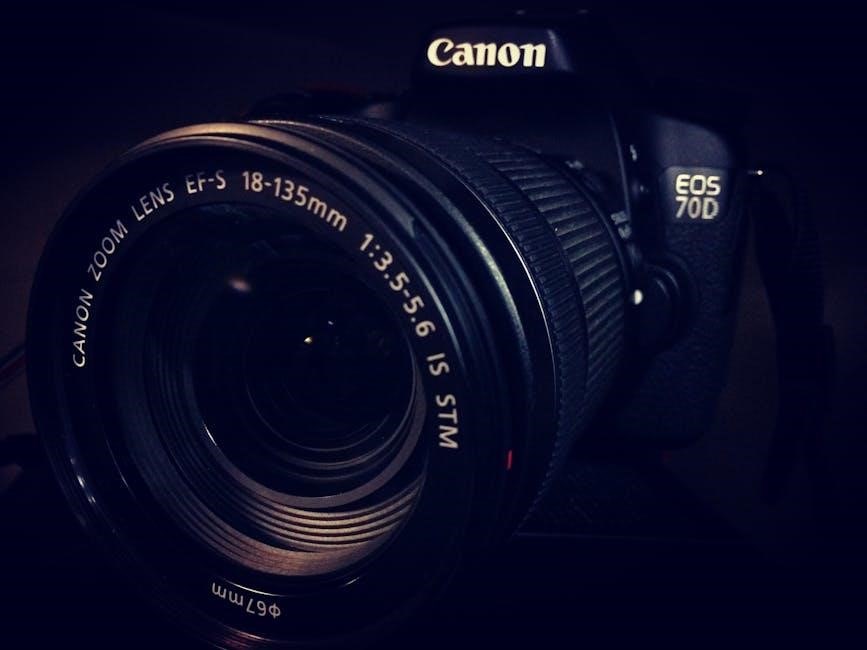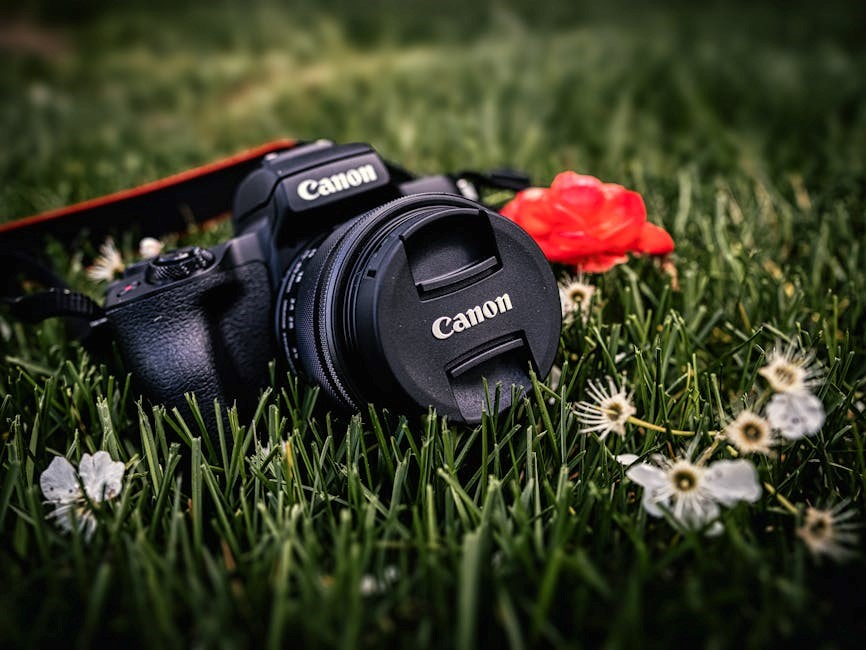Welcome to the Canon PowerShot SX50 HS manual! This guide helps users master the camera’s 50x zoom, manual controls, RAW shooting, and HD video capabilities for optimal performance.
1.1 Overview of the Camera and Its Features
The Canon PowerShot SX50 HS is a super-zoom compact camera featuring a 50x optical zoom (24-1200mm equivalent), 12.1MP CMOS sensor, and advanced manual controls. It supports RAW image capture, offering flexibility for post-processing. The camera includes Smart Auto mode for beginners and manual modes (P, Tv, Av, M) for advanced users. Additional features include HD video recording, customizable settings, and a vari-angle LCD screen. Its robust design and versatile functionality make it ideal for capturing distant subjects and creative photography.
1.2 Importance of Reading the Manual
Reading the Canon PowerShot SX50 HS manual is essential to unlock its full potential. The manual provides detailed insights into the camera’s advanced features, such as the 50x optical zoom, manual controls, and RAW image support. It helps users understand how to optimize settings for various shooting conditions and troubleshoot common issues. By following the guide, photographers can enhance their skills, ensure proper camera maintenance, and make the most of its HD video recording and customizable modes for stunning results.

Camera Basics and Initial Setup
Master the fundamentals of your Canon PowerShot SX50 HS, from unboxing to initial setup. Learn about battery charging, memory card insertion, and navigating basic camera controls for smooth operation.
2.1 Unboxing and Physical Description
When unboxing your Canon PowerShot SX50 HS, you’ll find the camera, battery, charger, strap, and manual. The camera features a compact, ergonomic design with a 12.1MP sensor. Its 50x optical zoom lens (24-1200mm) is a standout feature, offering versatility for various photography needs. The 2.8-inch vari-angle LCD screen provides excellent visibility. Weighing approximately 13.5 oz, it’s portable yet robust, designed for both ease of use and advanced functionality, making it suitable for photographers of all skill levels, from casual shooters to enthusiasts seeking professional-grade performance.
2.2 Charging the Battery and Inserting the Memory Card
Charge the battery using the provided charger. Insert the battery into the camera’s compartment, ensuring it clicks securely. Next, locate the memory card slot on the camera’s side. Gently push the card into the slot until it locks into place. Use a compatible SD, SDHC, or SDXC card. Ensure the card is properly seated to avoid data loss. After inserting, format the card via the camera’s menu for optimal performance. This ensures your Canon PowerShot SX50 HS is ready for capturing high-quality images and videos seamlessly.
2.3 Basic Camera Controls and Layout
Familiarize yourself with the camera’s controls. The Mode Dial on top selects shooting modes like Auto, P, Tv, Av, and M. The Shutter Button captures images, while the Zoom Lever adjusts the focal length. The Multi-Control Dial adjusts settings like aperture and shutter speed. The LCD screen displays settings and previews images. Use the buttons around the screen for navigation and menu access. The battery and memory card compartment are located on the bottom. Understand these controls to operate the camera efficiently and access its full functionality.

Shooting Modes
Explore various shooting modes to enhance your photography. From Smart Auto to Manual, the SX50 HS offers flexibility and creative control for every situation.
3.1 Smart Auto Mode for Beginners
Smart Auto Mode simplifies photography for newcomers, automatically adjusting settings for optimal results. It detects scenes and selects the best settings, ensuring sharp focus and proper exposure. Perfect for beginners, this mode eliminates the need to understand complex controls, allowing users to focus on composition. The camera handles everything, making it easy to capture high-quality images in various lighting conditions. With Smart Auto, you can enjoy effortless shooting while learning the basics of photography at your own pace.
3.2 Program Auto (P) Mode
Program Auto (P) Mode offers a balance between convenience and control, ideal for users transitioning from Smart Auto. The camera automatically sets aperture and shutter speed, but you can adjust settings like ISO, white balance, and flash to refine your shots. This mode is perfect for everyday photography, providing flexibility without the complexity of manual modes. It adapts well to various lighting conditions, allowing you to explore creative options while maintaining ease of use. Program Auto is a great stepping stone for those looking to enhance their photography skills.
3.3 Time Value (Tv) and Aperture Value (Av) Modes
Time Value (Tv) and Aperture Value (Av) modes offer partial manual control, ideal for photographers who want to prioritize specific aspects of their shots. Tv mode allows you to set the shutter speed while the camera adjusts the aperture automatically. Av mode lets you control the aperture, adjusting depth of field, while the camera handles the shutter speed. These modes are perfect for creative experimentation, such as freezing motion or blurring backgrounds, without the full complexity of Manual Mode. They provide a balance between control and convenience, enhancing your ability to capture unique images.
Manual (M) Mode empowers advanced photographers with full control over both aperture and shutter speed, allowing precise adjustments to suit creative visions. This mode is ideal for capturing low-light scenes, freezing fast-moving subjects, or achieving artistic effects like motion blur. Users can experiment with various combinations of aperture and shutter speed to achieve desired results. The SX50 HS’s manual mode supports RAW format shooting, enabling greater flexibility in post-processing. This mode is perfect for those familiar with photography fundamentals who seek ultimate control over their images. Custom (C1/C2) Modes allow users to save personalized shooting settings for quick access. These modes store preferences like aperture, shutter speed, ISO, and white balance, enabling seamless transitions between setups. Ideal for photographers who frequently switch between scenarios, such as landscapes and portraits, C1/C2 modes enhance creativity and efficiency. By saving unique configurations, users can adapt to various shooting conditions without recalibrating settings, making the SX50 HS even more versatile and tailored to individual photographic styles. The Canon PowerShot SX50 HS offers manual control options, enabling precise adjustments to aperture, shutter speed, and more, allowing advanced users to tailor settings to their creative vision. The Canon PowerShot SX50 HS allows users to manually adjust aperture and shutter speed, providing creative control over exposure. Aperture adjusts the lens opening, controlling depth of field, while shutter speed regulates light exposure duration. These settings can be fine-tuned using the control dial and on-screen interface, ensuring precise captures. Manual adjustments enable photographers to achieve desired artistic effects, from blurred motion to sharp landscapes, enhancing overall image quality and versatility in various shooting conditions. This feature is particularly beneficial for advanced users seeking professional-grade photography results. The Canon PowerShot SX50 HS offers manual focus control, allowing precise adjustments for sharp, detailed images. Manual focus is particularly useful in macro photography, portraits, or when autofocus struggles with low light or complex compositions. The camera’s focus peaking feature aids in achieving accurate focus by highlighting sharp areas. By enabling manual focus mode, users can override automatic settings, ensuring creative control and optimal results in challenging or artistic shooting scenarios. This feature enhances versatility for photographers seeking precise control over their compositions. The Canon PowerShot SX50 HS supports RAW image capture, enabling photographers to retain maximum image data for post-processing. RAW files preserve details in shadows and highlights, allowing for greater flexibility in editing. Unlike JPEGs, RAW images are uncompressed, ensuring higher quality and color accuracy. Shooting in RAW is ideal for advanced users who desire precise control over their images. This feature is particularly beneficial for capturing landscapes, portraits, and high-contrast scenes, where detail preservation is crucial. It enhances the camera’s appeal to professionals and enthusiasts alike. This section explores the Canon PowerShot SX50 HS’s image quality settings, including ISO, white balance, and resolution options, to help you achieve optimal photo results. ISO sensitivity determines the camera’s light-capturing ability. Lower ISOs (100-400) suit bright conditions, minimizing noise, while higher ISOs (800-6400) are ideal for low light, though they may introduce grain. The Canon PowerShot SX50 HS offers a wide ISO range, allowing users to balance image quality and lighting conditions effectively. Adjusting ISO settings can enhance photos in various environments, ensuring sharp and clear results. Understanding ISO sensitivity is crucial for mastering exposure and achieving professional-looking images with your camera. White balance ensures accurate color representation by adjusting to lighting conditions. The Canon PowerShot SX50 HS offers modes like Auto, Daylight, Shade, Tungsten, Fluorescent, and Custom. Auto automatically detects the color temperature, while Daylight and Shade adjust for natural light. Tungsten and Fluorescent correct for artificial lighting. Custom allows manual adjustment using a reference object. Proper white balance enhances image quality, minimizing unwanted color casts and ensuring vibrant, natural hues. This feature is essential for photographers seeking precise control over color accuracy in various environments; The Canon PowerShot SX50 HS allows users to adjust image resolution and compression settings for optimal quality and storage efficiency. Resolution options include 12.1MP (default), 8.0MP, 4.0MP, 2.5MP, and 1.0MP, with aspect ratios like 4:3, 3:2, 16:9, and 1:1. Compression uses JPEG formats: Fine (high quality, minimal compression) and Standard (lower quality, higher compression). Fine is ideal for detailed images, while Standard reduces file sizes. Customizing these settings balances file size and image quality based on your needs. This feature ensures flexibility for photographers seeking precise control over their images. The Canon PowerShot SX50 HS boasts a 50x optical zoom (24-1200mm), enabling extreme close-ups. Optical Image Stabilizer ensures sharp images at all zoom levels, while Intelligent IS enhances stability. Digital Zoom extends reach further for detailed shots, making it ideal for wildlife, sports, and landscape photography with precision and clarity. The Canon PowerShot SX50 HS features a remarkable 50x optical zoom lens, covering a focal range of 24-1200mm. This allows capturing wide-angle landscapes and distant subjects with exceptional detail. The lens’ broad range makes it versatile for various photography genres, from portraits to wildlife. Optical Image Stabilizer technology minimizes camera shake, ensuring sharp images even at maximum zoom. This feature-rich lens delivers outstanding optical performance, making it ideal for enthusiasts and professionals seeking precision and flexibility in their photography. Digital Zoom extends the camera’s reach beyond the optical limit, offering up to 100x total zoom when combined with the 50x optical zoom. While digital zoom can soften image details, using it wisely enhances flexibility. Enable Digital Zoom in the menu for distant subjects. For best results, shoot in well-lit conditions and use a tripod to minimize blur. Though not ideal for professional-grade images, it’s a practical tool for casual photography when getting closer isn’t possible, ensuring you capture the moment effectively. Playback mode allows you to view and delete images, while basic editing options enable quick adjustments to your photos directly on the camera, enhancing your review experience. Use the LCD screen to review your images, navigating with the arrow keys. Delete unwanted photos by pressing the trash button or selecting delete from the menu. Protect images to prevent accidental deletion. Transition between images using the right or left keys. Delete multiple images at once via the menu for efficiency. Ensure images are properly recorded before deleting. This feature helps manage storage and maintain organized photo libraries, enhancing your overall workflow with the Canon PowerShot SX50 HS. In playback mode, the Canon PowerShot SX50 HS offers basic editing tools. Resize images to reduce file size or crop to focus on specific details. Adjust brightness, contrast, and color balance to enhance image quality. Apply creative filters like sepia or black-and-white for artistic effects. Red-eye correction and noise reduction are also available. These features allow quick edits without a computer, making it convenient to refine your photos directly on the camera, ensuring your images look their best before sharing or storage. The Canon PowerShot SX50 HS supports HD video recording, offering high-quality footage with manual controls. Capture smooth videos using optical zoom and image stabilization for sharp results. The Canon PowerShot SX50 HS offers HD video recording with multiple shooting modes. Capture high-quality footage at 1080p or 720p resolutions, with frame rates like 24p or 30p. Users can choose from various modes, including Movie Digest and Super Slow Motion, for creative control. The camera also supports optical zoom during recording, ensuring sharp and steady videos. Selecting the best mode for your scene is easy via the menu system, allowing you to tailor settings for optimal results. This feature-rich system ensures professional-grade video capture with minimal effort. The Canon PowerShot SX50 HS offers customizable video settings for enhanced quality. Users can record HD video at 1080p or 720p, with frame rates of 24p, 25p, or 30p. Optical zoom is available during recording, ensuring sharp focus even at maximum zoom. The camera also features Movie Digest mode, which captures short clips before each still image. Quality options include Fine and Standard compression, reducing file sizes while maintaining clarity. Manual focus and exposure compensation are available for precise control, allowing users to tailor video settings to their creative vision. Explore recommended accessories like lenses, filters, and cases to enhance your Canon PowerShot SX50 HS experience. Regularly clean the lens and camera body for optimal performance. Enhance your Canon PowerShot SX50 HS with compatible lenses and filters. Tele converters can extend the camera’s 50x zoom range, while neutral density (ND) and polarizing filters improve image quality. Neutral density filters reduce light for better control over aperture and shutter speed. Polarizing filters minimize glare and enhance colors. Additionally, consider a lens hood to prevent lens flare and protect the lens. For added protection, use a high-quality UV filter. These accessories help maximize the camera’s potential for stunning photography. Regular maintenance ensures optimal performance of your Canon PowerShot SX50 HS. Use a soft, dry cloth to clean the lens and LCD screen, avoiding harsh chemicals. For stubborn smudges, dampen the cloth slightly with water. Avoid touching the lens surface to prevent fingerprints. Store the camera in a cool, dry place away from direct sunlight. Periodically check and update firmware for improved functionality. Refer to the manual for detailed cleaning instructions to preserve your camera’s longevity and image quality. Resolve common issues like battery drain, autofocus malfunctions, and memory card errors with step-by-step solutions and expert guidance from the manual. If your Canon PowerShot SX50 HS is experiencing battery drain, ensure the battery is fully charged and avoid extreme temperatures. Disable unnecessary features like GPS and auto-review to conserve power. Clean the battery contacts regularly and update the firmware for optimal performance. Replace the battery if issues persist. Proper care and maintenance can extend battery life and ensure reliable operation during photography sessions. For autofocus issues on your Canon PowerShot SX50 HS, restart the camera and ensure the lens is clean. Use manual focus if autofocus fails. For zoom malfunctions, check for obstructions and clean the lens. Reset camera settings to default and update firmware. If problems persist, contact Canon support or visit a service center for professional assistance to restore proper functionality and ensure your camera operates smoothly. Experiencing memory card errors with your Canon PowerShot SX50 HS? Common issues include the camera not recognizing the card or formatting errors. Ensure the card is compatible and properly inserted. Format the card in the camera settings to resolve recognition problems. If errors persist, use a card reader to check for corruption. Clean the card’s contacts and ensure it’s not full. If issues remain unresolved, consider replacing the memory card to ensure smooth operation and prevent data loss during shooting sessions. Visit the official Canon support website to download drivers, software, and firmware for your PowerShot SX50 HS. Regular updates ensure optimal performance and functionality. Accessing Canon support resources is straightforward. Visit the official Canon website and navigate to the support section. Search for the PowerShot SX50 HS to find dedicated drivers, software, firmware, and troubleshooting guides. Download the user manual or access FAQs for detailed assistance. Regularly updated resources ensure optimal camera performance and help resolve common issues efficiently. Updating the firmware on your Canon PowerShot SX50 HS enhances functionality and fixes issues. Visit the official Canon website, navigate to the support section, and download the latest firmware version. Follow the on-screen instructions to install the update, ensuring your camera is connected to a power source or has sufficient battery life. Regular firmware updates ensure optimal performance, improved compatibility, and access to the latest features for a better shooting experience. The Canon PowerShot SX50 HS manual provides comprehensive guidance for mastering its 50x zoom, manual controls, and RAW capabilities, ensuring users unlock its full potential effortlessly. By exploring the advanced features like the 50x optical zoom, manual controls, and RAW image format, users can fully exploit the capabilities of the Canon SX50 HS. Understanding ISO sensitivity, white balance, and custom shooting modes allows for enhanced creativity. Regularly updating firmware and maintaining the camera ensures optimal performance. Experimenting with different settings and techniques, as outlined in the manual, helps photographers capture stunning images and videos, making the SX50 HS a versatile tool for both amateurs and professionals alike. To achieve exceptional results with the Canon SX50 HS, always use a tripod for stability, especially at maximum zoom. Shoot in RAW format to preserve image details and enable better post-processing. Experiment with different shooting modes like Manual and Custom to tailor settings to your creative vision. Regularly clean the lens and sensor to maintain image clarity. Finally, review your shots in playback, utilizing the camera’s editing features to refine your work and ensure your photos stand out.3.4 Manual (M) Mode for Advanced Users
3.5 Custom (C1/C2) Modes
Manual Control Options
4.1 Adjusting Aperture and Shutter Speed
4.2 Manual Focus and Its Applications
4.3 Using RAW Image Format

Image Quality and Settings
5.1 Understanding ISO Sensitivity
5.2 White Balance and Color Accuracy
5.3 Image Resolution and Compression

Zoom and Optical Features
6.1 50x Optical Zoom Range (24-1200mm)
6.2 Using Digital Zoom Effectively

Playback and Review
7.1 Viewing and Deleting Images
7.2 Basic Editing Options in Playback

Video Recording Capabilities
8.1 HD Video Shooting Modes
8.2 Video Settings and Quality Options

Accessories and Maintenance
9.1 Recommended Lenses and Filters
9.2 Cleaning and Maintaining the Camera

Troubleshooting Common Issues
10.1 Resolving Battery Drain Problems
10.2 Fixing Autofocus and Zoom Malfunctions
10.3 Addressing Memory Card Errors

Downloading Drivers, Software, and Firmware
11.1 Accessing Canon Support Resources
11.2 Updating Firmware for Improved Performance
12.1 Maximizing the Potential of the Canon SX50 HS
12.2 Final Tips for Getting the Best Results


